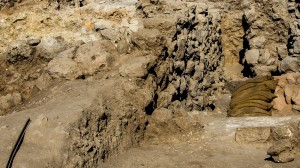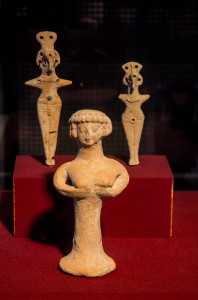Wednesday—yesterday—was Yom Kippur, and we are in the height of the fall Jewish holy season. This prompted me to write a bit on the Day of Atonment to illustrate how Christians appropriate theologically and practically the OT ritual law. I’m also using this as an excuse to salt in pictures I’ve taken at site sacred in ancient Israel, some of which ceased to be sacred and fell under divine judgment.
I shared a general framework yesterday based on 1 Corinthians 10:11, so today I want to plunge into the texts on the Day of Atonement. It’s vital here, however much the concrete realities of the ancient historical rituals need to be in view—and I’m all about that—we are nevertheless reading a text. Background is important, but here I’ll share with you one of the central interpretive principles I try to get across to my students:
Background must not obscure Foreground!
We can never, ever let elements of background, the ancient Near Eastern historical and cultural context, however fascinating and compelling, lead us to obscure the foreground, the text itself, bending and warping it warp itaway from its plain, grammatical

and literary sense, subverting its own emphases, substituting a set of issues drawn from outside the text. This matters because often the biblical writers consciously sought to subvert and transcend their ancient cultural setting, and we dare not risk pushing them back into what they just tried to rise above! The text alone is the inspired word of God, the rule of faith, not our reconstructed historical and cultural background scenarios, however intriguing they might be—and however vital they might be to understanding the canonical text.
So…on to Leviticus 16-17…
The two chapters on the Day of Atonement (Leviticus 16-17) link the two main sections of Leviticus, chapters 1-15 which teach about how a holy God is to be approached, and the chapters 18-25, which teach, consequentially, how a holy God is to be served. The word “atone” (Hebrew √ﬤפר which, curiously, in addition to “atone” also means “seal, waterproof”) dominates Leviticus 1-15 but hardly appears at all in Leviticus 18-25. Likewise, the word “holy” (Hebrew √קדשׁ) in all its forms (holy, holiness, sanctify, consecrate) hardly appears in Leviticus 1-15 except to denote the “most holy” place or “most holy” part of the offering (only exception is Lev. 11:44-45 which anticipates the thees of Lev. 18-25) but as a category for human identity and conduct, it becomes programmatic for Leviticus 18-25. So we have a book of atonement (Lev 1-15), which provides a basis for a book of holiness (Lev 18-25), with the Day

of Atonement (Lev 16-17) mediating and integrating the two. Leviticus culminates in blessings and curses for faithfulness or betrayal of Yahweh, and closes out by posing the curious question…what if after 26 chapters, the reader still wants to do even more for Yahweh? The whole world of voluntary vows (Leviticus 27) turns the light on the possibility that the whole “sacrificial system” might in fact not be the real story, but prepares the worshiper, the reader, for the world of radically open, voluntary devotion of anything and everything we have and are, and ultimately ourselves, to God.
So smack in the center of this “system” dealing with atonement (1-7), mediation (8-9), healing of brokenness (10-15), visions of holiness (18-20), sustainable leadership (21-22) and the hallowing of time (23-25) stand these two chapters dealing with the Day of Atonement (Leviticus 16-17). So whatever Leviticus, as a text, not as a performed traditional ritual, wants to teach us about the “religious system” or “ritual system” of the OT, it forces us to confront the primacy and pervasive influence of this central section.
For now, I want to stress two points, which Leviticus 16-17 and 23:26-32 make through a variety of statements.
First, five times in conjunction with the Day of Atonement (Lev. 16:29, 31; 23:27, 29, 32), the worshiper is called to “afflict your soul.” The term “soul” (Hebrew נֶפֶשׁ) has long been known not to mean “soul” in the dualistic sense of the intangible “real you” separated from the body. I did a little popular level summary of that matter some years ago in a chapter of a book devoted to the soul and neuroscience. The term really seems, ironically, to zero in on the body, or rather, the embodied condition of human life. So here it means more

“affllict yourselves” with “self” meaning not just something psychological or spiritual, but our total selves. Jews on Yom Kippur implement this by fasting, even from drinking water! Clearly, though, whatever “afflict” means, this is not about some single religious abstinence, but an act directed at the entire force of a person’s life. One can avoid food and water for a day and in no way strike a blow at the underlying force of self, of ego that drives all our appetites.
The word traditionally translated “afflict” is striking as well. The term (Hebrew ﬠִנָּﬣ the Piel form of √ﬠנﬣ) can express some pretty severe senses. It is used by writers expressing the emaciated, tormented condition, a cringing, desperate person; someone who is physically crouched down, bunched up, utterly wretched. The form used here means to put someone in that condition. It is used to denote oppression, submitting someone to dependency, to humiliate, and in some cases, it appears to suggest violent personal humiliation and degradation. Strong stuff! Needless to say, the Hebrews did not regard the human self as this delicate, fragile thing that needed to be nurtured and encouraged. “Self esteem” was not a big value to the OT saints. Rather, the OT sees human nature as power-hungry, heedless and grasping, always seeking to control, to dominate, even to oppress, and therefore in need of forceful restraint, of humbling and learning of lowliness. The Day of Atonement calls upon the worshiper to learn lowliness of soul, to rein in an out-of-control life, to deal the defiant, self-willed life of both body and spirit a crashing blow of self-renunciation.
Sound familiar? Stripped of our pious associations, it’s what Jesus meant when he said those whoever would follow him must “…deny themselves, take up the cross…” We sugar coat and domesticate that, but his call was to a complete crucifixion of the human ego to be re-made in his own image, in holiness. Paul said, “I am crucified with Christ,” not “I am nurtured in self-realization in Christ!” Crucifixion…that’s gonna leave a mark!
I will hasten to add, though, that lest we think of the OT as morbid and misanthropic…in the OT ritual calendar, there is only one, single, solitary day of the year that calls a Yahweh-worshiper to “afflict the soul.” The dominant note elsewhere is one of life-affirmationa and celebration. I suppose with the inner poisonous serpent of self-assertion slain, one would have real cause to celebrate, not to mention the others around us!
Second, and related to the “affliction of soul,” the Day of Atonement is what you could call an xTreme Sabbath! The Hebrew construction is a little peculiar, שַׁבַּת שַׁבָּתוֹן shabbat shabbatôn. While not used exclusively for special holy days, it is certainly distinctive of those uses. The Day of Atonement would not have fallen typically on a Sabbath day, so the day where it did fall, whatever that day, became a Sabbath, and one of particular importance. The text repeatedly stresses that on this day no work of any kind is to be performed, though the actual day of the week is not the regular Sabbath. Jews traditionally understand this “no work” to be even less work than a normal “no work” Shabbat! Again, this is one reason why Jews traditionally abstain from both food and water for the 25 hours of Yom Kippur’s observance.
So our first two clues on the Day of Atonement and the centerpiece of the “religious system” of the OT is that it is to be marked by a radical de-throning of the human self, expressed concretely in a prohibition on all manner of work.
Imagine…a “religious system” of rituals, regulations, sacrifices and offerings, but whose central requirement is we are to be forgiven and cleansed is…resigning from running the universe, and doing absolutely nothing.
—To Be Continued!



One Response
“Crucifixion—that’s gonna leave a mark!”
Very interesting blog Lawson.
Thanks for your postings.